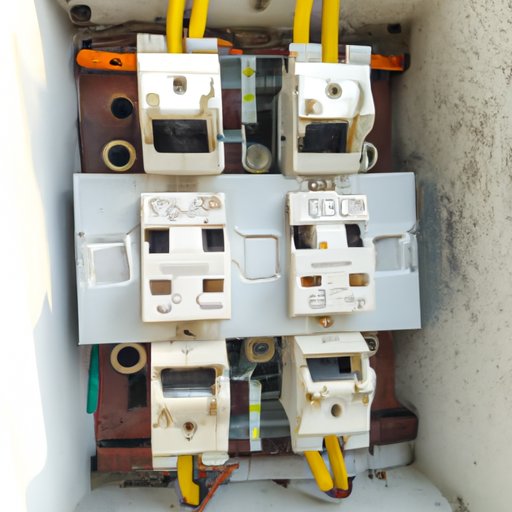Introduction
Circuit breakers are essential components of any electrical system. They are designed to protect your home from dangerous power surges by automatically cutting off power when overloaded circuits become too hot. However, sometimes circuit breakers can malfunction and trip without warning. If this happens, it’s important to know how to troubleshoot and fix the problem before it becomes a bigger issue. In this article, we will explore the steps you need to take to troubleshoot and repair a tripping circuit breaker.
Step-by-Step Guide to Troubleshooting a Tripping Circuit Breaker
The first step in troubleshooting a tripping circuit breaker is to check the breaker box for proper wiring. Make sure all wires are securely connected and that no loose or frayed wires are present. You should also check for signs of overheating, such as a burning smell or discolored wires. If you find any of these issues, shut off the power immediately and contact an electrician for further assistance.

How to Identify and Resolve Common Causes of Circuit Breaker Tripping
Once you’ve checked the breaker box for any signs of overheating, it’s time to identify and resolve the cause of the tripping circuit breaker. The most common causes are electrical overload, faulty appliances, short circuits, and ground faults.
An electrical overload occurs when too much current is running through the circuit. This can be caused by overloading the circuit with too many appliances, or by using appliances that draw more current than the circuit can handle. To fix this issue, you’ll need to reduce the load on the circuit by unplugging some appliances or switching them over to a different circuit.
A faulty appliance can also cause a circuit breaker to trip. If you suspect a particular appliance is the culprit, try unplugging it and plugging it into a different outlet. If the circuit breaker continues to trip, the appliance may need to be replaced.
Short circuits occur when the live wire comes into contact with the neutral wire, creating a direct path for current to flow. This can damage the wiring and cause the circuit breaker to trip. To fix a short circuit, you’ll need to trace the wires back to the source of the problem and replace any damaged sections of wiring.
A ground fault is similar to a short circuit, but instead of the live wire coming into contact with the neutral wire, it comes into contact with the ground wire. This can also cause the circuit breaker to trip. To fix this issue, you’ll need to trace the wiring back to the source of the problem and replace any damaged sections of wiring.

Know the Signs: Diagnosing Problems with Your Circuit Breaker
In addition to the above causes of circuit breaker tripping, there are several other signs that something may be wrong with your circuit breaker. If you notice any of the following symptoms, it’s important to shut off the power and contact an electrician:
- Burning smell – This could indicate an overheating circuit.
- Visible damage – Look for signs of wear or corrosion on the circuit breaker.
- Unusual noises – Listen for any strange buzzing or humming sounds coming from the circuit breaker.
Tips for Homeowners: How to Fix a Tripping Circuit Breaker
If you’re comfortable working with electricity, there are several steps you can take to troubleshoot and repair a tripping circuit breaker. First, use a multimeter to test the connections in the breaker box. If the connections are good, then you can move on to checking GFCI outlets. If the outlets are not functioning properly, then you may need to replace the breaker.
If the breaker box and GFCI outlets check out, then it’s time to do some DIY electrical troubleshooting. Start by turning off all the circuit breakers in the panel. Then, one at a time, turn them back on and test each one. If the breaker trips again, then you’ll need to check the receptacles and switches on that circuit to see if anything is amiss. If you find any signs of damage or overheating, then you’ll need to replace the affected wiring.

DIY Electrical Troubleshooting: When Your Circuit Breaker Keeps Tripping
If your circuit breaker keeps tripping even after you’ve checked the breaker box, GFCI outlets, and wiring, then it’s time to do some more advanced troubleshooting. Start by turning off all the circuit breakers in the panel. Then, one at a time, test and reset each breaker. If the breaker trips again, then you’ll need to check the receptacles and switches on that circuit to see if anything is amiss.
If you find any signs of damage or overheating, then you’ll need to replace the affected wiring. It’s also a good idea to have an electrician inspect the entire system to make sure everything is up to code. This will help prevent future problems and ensure your safety.
Conclusion
Troubleshooting and repairing a tripping circuit breaker can be a daunting task. However, with a little patience and knowledge, you can identify and resolve the problem yourself. Start by checking the breaker box for any signs of improper wiring, then look for signs of an electrical overload, faulty appliances, short circuits, and ground faults. Finally, use a multimeter to test the connections and replace any damaged wiring. With the right tools and knowledge, you can safely and effectively repair a tripping circuit breaker.
Remember, if you ever feel uncomfortable or unsafe while troubleshooting and repairing your circuit breaker, it’s best to call a professional. An experienced electrician can quickly diagnose and repair any issues with your breaker, saving you time and money in the long run.
(Note: Is this article not meeting your expectations? Do you have knowledge or insights to share? Unlock new opportunities and expand your reach by joining our authors team. Click Registration to join us and share your expertise with our readers.)
